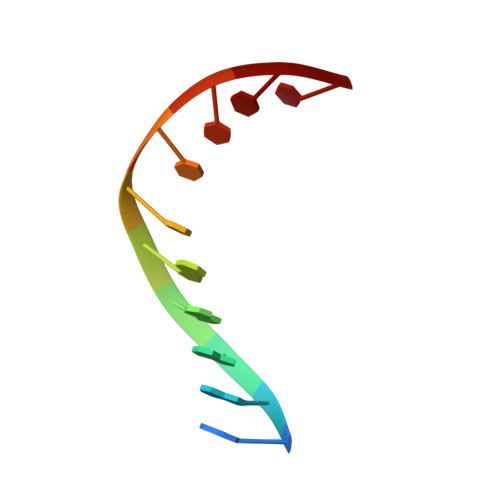Structures of HO(2)-Co(III)bleomycin A(2) Bound to d(GAGCTC)(2) and d(GGAAGCTTCC)(2): Structure-Reactivity Relationships of Co and Fe Bleomycins
Zhao, C., Xia, C., Mao, Q., Forsterling, H., DeRose, E., Antholine, W.E., Subczynski, W.K., Petering, D.H.(2002) J Inorg Biochem 91: 259-268
- PubMed: 12121784
- DOI: https://doi.org/10.1016/s0162-0134(02)00420-8
- Primary Citation of Related Structures:
1MTG, 1MXK - PubMed Abstract:
HO(2)-Co(III)bleomycin is a model for HO(2)-Fe(III)bleomycin, which initiates single and double strand cleavage of DNA. In order to enlarge the understanding of its structure and reactivity, three-dimensional structures of HO(2)-Co(III)bleomycin bound to two DNA oligomers, d(GAGCTC)(2) (I) and d(GGAAGCTTCC)(2) (II), that have 5'-GC-3' binding sites, have been determined by nuclear magnetic resonance (NMR) methods. Besides previously recognized determinants of binding selectivity, a probable hydrogen bond was detected between the pyrimidinyl acetamido NH(2) and the carbonyl of cytosine base paired to G at the recognition site. Another hydrogen bond between the NH of the dimethylsulfonium R group and N7 of guanine opposite cytosine at the GC site may contribute to specification of the pyrimidine. Substitution of G with inosine shifted HO(2)-Co(III)Blm A(2)[bond]I and Fe(III)Blm[bond]I into fast exchange on the NMR time scale, supporting the role of the 2-amino group in site specification for each molecule. The conformationally stable metal-domain linker established a close-packed adduct with the minor groove in which the hydroperoxide ligand occupies a sterically constrained pocket that is isolated from the solvent. The hydroperoxide group is directed toward one of the two cytosine H4' hydrogens but is sterically blocked from access to the other by the drug. These findings enlarge the structural understanding of selective binding of Co(III)/Fe(III)Blm species at G-pyrimidine sites. They also rationalize the instability of a number of ligands bound to Co(III)/Fe(III)Blm at specific binding sequences and the relative unreactivity of Fe(III)Blm[bond]I with ascorbate as well as its lack of interaction with spin labels.
- Department of Chemistry, University of Wisconsin-Milwaukee, Milwaukee, WI 53201, USA.
Organizational Affiliation:



















